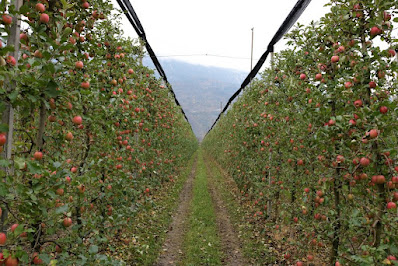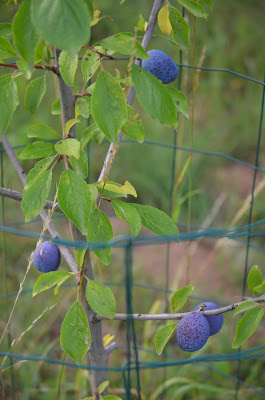Once, the earth was covered with plants only of shades of green, brown and orange, with simple flowers - like 1970s wallpaper. Then came a psychedelic revolution. Insects began searching for protein-rich pollen for food and carried it from flower to flower on their bodies, increasing pollination which before had relied on the wind. The most successful flowers were those which attracted most insects and maximised pollen uptake - resulting in the evolution of bright colours, scents, and intricate shapes and patterns. This is where the orchids excelled - they became the extreme essence of flowers and advertised the promise of sweet nectar or sex. However, orchids can be great deceivers, and they may not provide food or sex to thank the insects for their efforts. I think orchids draw us in because they exude something familiar beyond beauty - an abstraction of the animals that move through our lives. It is as if they could move without the wind.
In our first Spring in the house, at the end of March, we noticed an orchid on the front lawn: a Green-winged Orchid (Anacamptis morio). We were very excited, and thought of ways we could protect it. But as March turned to April more and more appeared in the garden, until there were hundreds around the house - particularly in the small hay meadow (where in future they will grow between the rows of fruit trees). By flowering early, they are one of the few flowers available for emerging queen bumblebees to visit and pollinate - but they deceive them and do not provide nectar.
As April progressed, patches of Tongue Orchids (Serapias lingua), a Mediterranean species, appeared in front of the hill meadow and among the trees by the small hay meadow. They are pollinated by a small black bee, Ceratina cucurbitina, which they sexually decieve by producing chemicals similar to its mating pheromones.
At the edge of the large hay meadow, a small group of Burnt Orchids (Neotinea ustulata). They attract Tachinid flies for pollination with a scent like honey, but again deceive them by not providing nectar.
Tucked away in the trees by the small hay meadow, a woodland orchid - Narrow-leaved Helliborine (Cephalanthera longifolia). It is pollinated by deceiving solitary bees such as Halictus and Lasioglossum for food.
April turned to May and, in the oak wood, a single Greater Butterfly-orchid (Platanthera chlorantha). This orchid does produce nectar, but it is found at the bottom of a 30mm long tube, and it produces a vanilla scent, but at night. Both of these facts have lead to the assumption that the orchid is pollinated by insects with a long proboscises, at night - moths.
I did not need to search for Pyramidal Orchids (Anacampus pyramidalis) as they were growing in the gravel under a tree in the courtyard. They are also pollinated by lepidoptera, which they provide with nectar.
Then appeared some orchids which take sexual deception to incredible extremes - the Bee Orchids (Ophrys). They are mostly Mediterranean and, despite looking totally unique in their complexity, there are around 200 species - making them the largest group of orchids. The flowers mimic the form and sex pheromones of female bees, and male bees will pollinate the flowers whilst trying to copulate with them. Each species mimics a different specific pollinator. The bees do become wise to this trick, and only around ten percent of flowers are pollinised each year - but each flower will produce thousands of seeds.
On our front lawn grow a number of common Bee Orchids (Ophrys apifera). They attract the solitary bee Eucera longicornis.
Take a closer look. It really is a little furry lady bee.
On a bank at the edge of the small hay meadow a bunch of Early Spider-orchids (Ophrys sphegodes). It's pattern is very variable over Europe, and 16 sub-species have been described. It is not pollinated by spiders though, but by the miner bee Andrena nigroaenea.
Anyone can see it is a cuddly little solitary bee, not a spider.
Like the Spider-orchids, other orchids are described by the animals we see in them - not the insects they attract. Growing out of the bank of the front drive I noticed a Man Orchid (Orchis anthropophora). It is mainly pollinated by small beetles and sawflies.
Indeed the flowers do look like little men - with cycling helmets.
Entering the height of summer, in June, a few Lizard Orchids (Himantoglossum hircinum) sprouted next to the ageing Bee Orchids on the front lawn. They are not pollinated by lizards (though there are plenty close by) but are believed to be food-deceptive, given off an attractive scent to attract mainly bees - but not providing nectar. The latin name hirsinum means 'smelling like a goat'.
The flowers really are reclining lizards. But with cycling helmets?
Just when it seemed summer was over, in September, large numbers of Autumn Lady's Tresses (Spiranthes spiralis) spiralled their way out of the front lawn and garden. Their fragrance, close to vanilla or almonds, attracts a wide variety of bees for pollination - and they are rewarded with nectar.
I used to think orchids were plants of nature reserves, requiring a special trip to protected places - but they are all around us. We have enjoyed eleven species in our garden alone. What will we see if we walk outside...?



















































